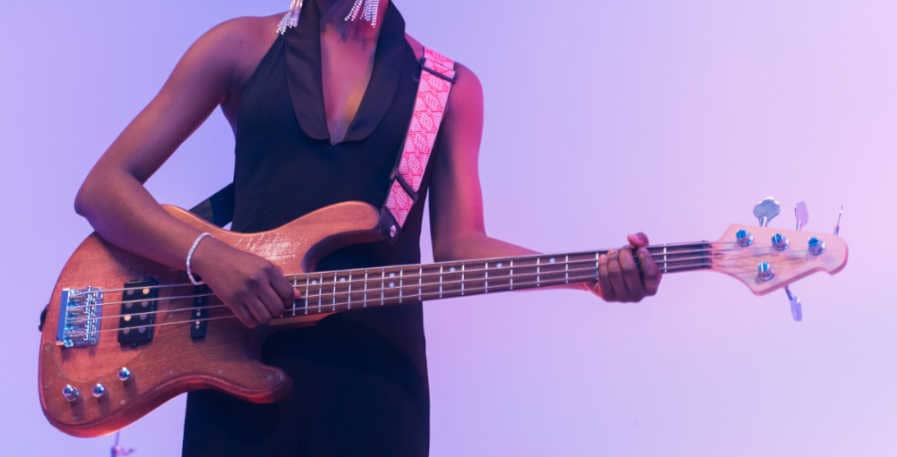Two, three, and sometimes even four. Bassists vary a lot in how many fingers they use for plucking. Some even like to think that the more fingers they use, the better. But if this is true, why do some of the most iconic bassists of all time play the bass with just one finger?
One reason for this is that playing bass with one finger can produce a sound that is smooth as well as funky and powerful. A big reason few bassits adopt this style, is however that it can be incredibly hard to master.
There is also a good bit of misconceptions out there about what 1-finger style is and isn`t. Therefore, I have written this guide to clarify what this technique is all about.
I will show you the pros and cons of playing with one finger and my personal experience with the technique. Then, I will explain why playing with one finger is generally thought of as difficult. Lastly, I showcase a handful of bassists that play with one finger and explain what makes their styles different.
Can you play bass with one finger?
While most fingerstyle bassists play with two or three fingers, it is also possible to play the bass with just one finger. In general, it is a more demanding style of playing, but one that multiple proficient bassists have utilized in various genres.
Contrary to popular belief, playing with 1 finger is also by no means slower than playing with 2 or 3 fingers. Some of the fastest bass players I have ever seen have played with 1 finger. This is mainly due to them being able to do both up and down strokes with their finger.
“The advantage of a pick is that you can go up-strokes and down-strokes back and forth, so I just started varyig that style and added some funk to it.”
Geddy Lee – 2015 Interview with Fender
They also generally mold and adapt the style to make it their own. Thus, if you want to learn to play with a single finger it is best to study multiple bassists. This is because their styles can vary greatly, and different 1-finger styles will be more natural to you than others.
Personally, I can reach higher peak speeds with 1 finger than with 2, despite mainly playing bass with 2 fingers. However, other bass players will claim that using 2, 3, or 4 fingers is the fastest and most consistent way to play. Thus, there is no universal answer to which technique is objectively fastest, and as always, it largely comes down to preference.

Why playing bass with one finger is hard
Playing the bass guitar with 1 finger is challenging because it requires you to develop stamina, dexterity, and control. Developing these skills is time-consuming, and can be difficult and deterring for beginners.
Here is a little more info about why playing bass with 1 finger can be so challenging:
- Stamina – A major argument for using 3 fingers instead of 2, is that you will wear your fingers out slower. This is because each individual finger is doing less work, which will allow you to play for longer periods of time. Thus, playing with 1 finger will wear your finger out faster than if you were playing with 2 or 3. You can also expect to develop calluses faster this way.
- Switching between strings – When playing with multiple fingers, a finger can move to another string while another is playing a note. This luxury is lost when playing with 1 finger. Thus, you will need to develop both dexterity and control in order to smoothly switch between strings.
- Consistency – Getting a consistent tone with 1 finger is easier than with 2 or 3 when playing simple bass lines. However, when you have to play quick basslines for extended periods, or one that switches between strings a lot, this consistency becomes harder to maintain. It will thus take a lot of practice to maintain a consistent tone throughout demanding songs, not to speak of full live sets.
- Time commitment – For the above reasons, you will need to put in a good bit of practice if you are to get good at playing with 1-finger. This can result in a lack of motivation or a sense that you are not progressing fast enough. This is normal, and I advise against giving up when it happens, but it is something you should be prepared for if you do commit to playing with 1 finger.
Bassists who play with one finger
There have been multiple bassists who have utilized a finger technique at some point. Notice how all of the bassists listed below have their own unique style for how to play with 1 finger:
- Geddy Lee – Rush`s bassist is known for playing complex basslines, in odd time signatures, while somehow managing to sing at the same time. He uses his index finger like a vertical pick, plucking the strings with his nail. As a result, his tone has a strong and noticeable attack and has an aggressive character to it.
- James Jamerson – Jamerson did a lot to make his tone unique and smooth. What really made it stand out was mainly using 1 finger and using it for playing multiple strings on upstrokes. A lot of this can be attributed to him previously playing the double bass, which requires a lot more individual finger strength than the electric bass.
- Jack Bruce – Cream`s legendary bassist drew inspiration from Indian instruments that are played with a single finger. He adopted this style to fit within rock music, and thus pioneered a unique style, even among 1-finger players.
- Dough Wimbush – Mainly known for his work with Living Colour, Wimbush uses 1 finger to play the bass in various ways. Most notably, he uses his index finger to tap the bass like a slap player would with their thumb. He does so without moving his wrist, but rather by using his hand as a seesaw. This all allows him to play incredibly fast while maintaining a consistent tone.
As you can see, bassists who played with 1 finger often did so as a result of experimentation and thinking outside the box. Thus, these bassists were all groundbreaking in their own unique way.
Conclusion
Playing bass with one finger is a style that will not suit everyone. However, bassists that commit to and master the style generally develop into innovative, unique, and highly skilled musicians.
I occasionally play with 1 finger when faced with tremolo parts that are relatively short. I also like to use the style for songs where I`m playing a lot of half and whole notes. Aside from that, I prefer sticking with 2 fingers.
Lastly, if you feel inspired to try playing bass with 1 finger I want to leave you with two main takeaways:
First, be ready to practice a lot. It will take time, and it will feel unmotivating at times. Remember then that you are always making progress, even when it feels like you are not.
Second, develop your own style. The majority of iconic 1-finger players out there all have completely unique and personal styles. Rather than emulating any one of them, try to find inspiration everywhere you can and mold that into a style that is fully your own.
So, how much do you need to practice in order to play with 1-finger proficiently? That depends on what your goals as a bassist are. To learn more, read about how often you should practice the bass.

